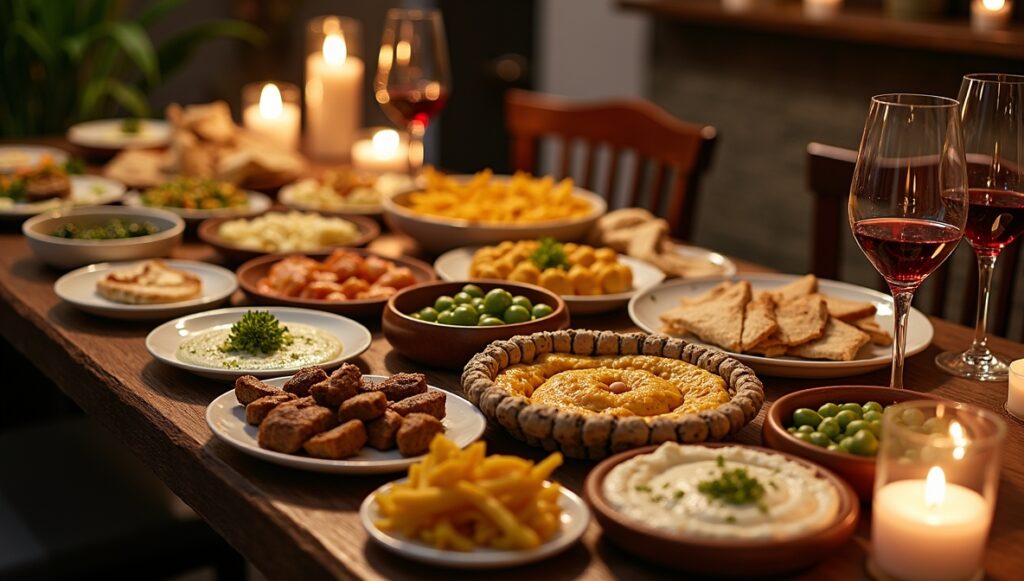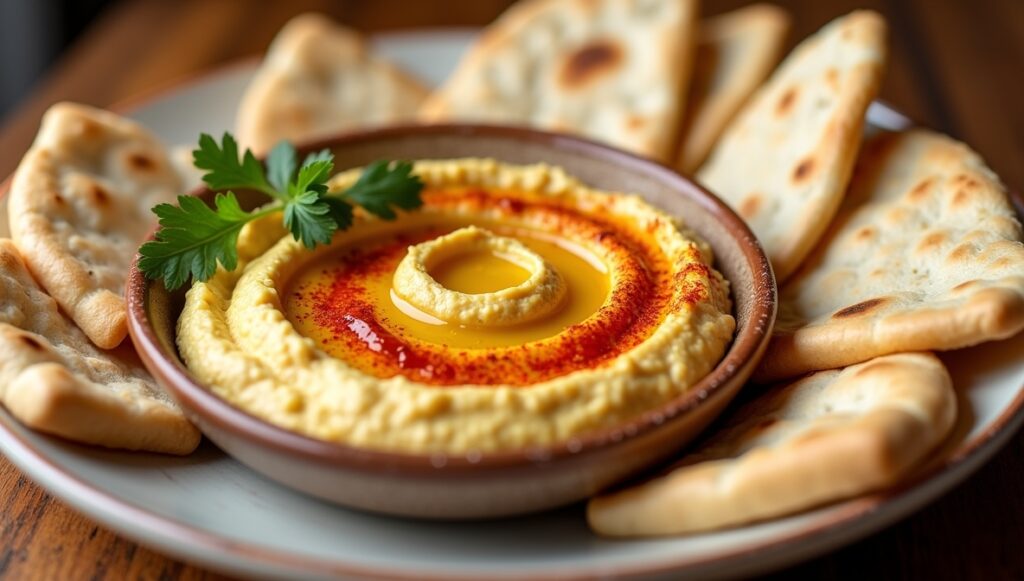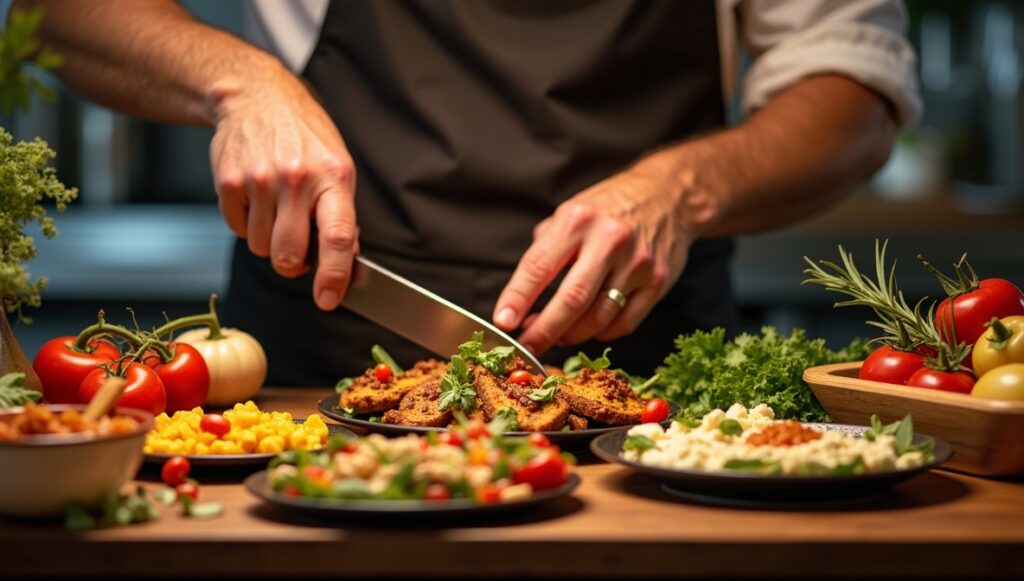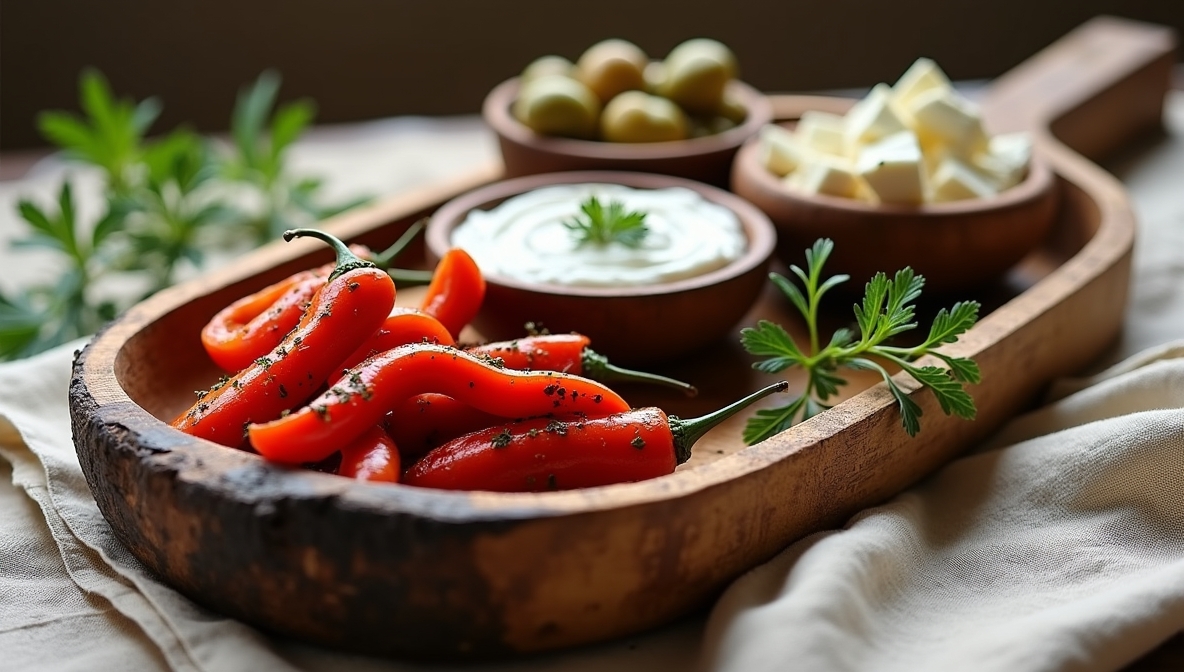Introduction
Colorful, flavorful, and incredibly communal—Mezze (or meze) is not just a dish in Turkey; it’s a way of life. This vibrant collection of small plates is central to Turkish dining culture, inviting conversation, hospitality, and shared joy. Whether served as appetizers or as a full meal, mezze showcases the rich tapestry of Turkish ingredients and culinary traditions. Loved for its diversity, health benefits, and social charm, mezze is a must-try for anyone exploring Turkey’s food scene.


History & Cultural Significance
The word “mezze” comes from the Persian word “mazzeh”, meaning “taste” or “relish”. Its origins date back to the Ottoman Empire, where a variety of small plates were served alongside drinks in imperial courts and taverns.
Over time, mezze became integral to Turkish hospitality. Whether during religious holidays, weddings, or casual get-togethers, meze plays a key role. It’s not just about eating—it’s about bonding over a table filled with shared dishes, stories, and laughter.
Ingredients & Regional Variations
Key Ingredients:
Fresh vegetables (tomatoes, eggplants, cucumbers)
Olive oil
Legumes (chickpeas, lentils)
Yogurt
Seafood
Herbs & spices (mint, sumac, paprika)
Popular Mezze Dishes:
Haydari (yogurt with garlic and herbs)
Ezme (spicy tomato and pepper dip)
Şakşuka (eggplant in tomato sauce)
Dolma (stuffed grape leaves)
Fava (mashed broad beans)
Regional Twists:
Aegean Mezze: More seafood-based, with a Mediterranean flair.
Southeastern Turkey: Spicier variations, often with grilled meats or nuts.
Istanbul-style: Influenced by Greek and Armenian communities, includes cheeses, pickles, and cured fish.
Modern Takes: Restaurants now offer fusion mezze, incorporating avocado, quinoa, or even sushi elements while maintaining the sharing concept.
Cooking Process & Difficulty Level

Difficulty: Beginner to intermediate
While some mezze dishes require more skill, most are beginner-friendly and involve minimal cooking.
Basic Mezze Platter (Quick Guide):
Haydari – Mix yogurt, crushed garlic, mint, and olive oil.
Ezme – Finely chop tomatoes, onion, parsley, and green peppers. Mix with pomegranate molasses and chili flakes.
Şakşuka – Sauté eggplant cubes, top with garlic-tomato sauce.
Stuffed Olives & Cheese – Add ready-made or store-bought delicacies.
Serve with: Warm pita or lavash bread.
Where to Eat Mezze in Turkey
Top Spots:
Ciya Sofrası (Istanbul): Famous for its extensive meze offerings and authentic Anatolian flavors.
Karaköy Lokantası (Istanbul): A stylish spot with beautifully crafted meze plates.
7 Mehmet (Antalya): Michelin-rated restaurant serving traditional meze with a fine-dining twist.
Asmalı Cavit (Istanbul): Classic tavern ambiance with beloved meze and raki pairings.
Akin Balik (Izmir): Coastal seafood meze, especially good at sunset.
Pairing with Drinks & Side Dishes
Traditional Pairings:
Rakı – Turkey’s iconic anise-flavored spirit, often dubbed “lion’s milk”.
Ayran – Salted yogurt drink for a refreshing touch.
White Wine or Light Beer – Complements the zesty and herby flavors.
Side Dishes:
Pide (Turkish flatbread)
Grilled lamb skewers
Pickled vegetables
Roasted nuts
Fun Facts & Lesser-Known Trivia
Shared Dining: Mezze is rarely eaten alone—it represents unity and community.
Celebrity Favorite: Chef Anthony Bourdain featured Turkish mezze during his visit to Istanbul.
Global Similarity: Meze is a cousin to Spanish tapas, Greek mezedes, and Middle Eastern small plates.
Health Benefits & Nutrition
High in Fiber: Thanks to legumes and vegetables.
Rich in Healthy Fats: Olive oil is a key ingredient.
Low Carb Options: Great for keto or Mediterranean diets.
Vegan Friendly: Many meze dishes are naturally plant-based and gluten-free.
How to Cook It at Home (Best Mezze Recipe)
Ingredients for a Basic Mezze Platter:
1 cup thick yogurt
1 garlic clove, minced
1 tbsp olive oil
2 eggplants
2 tomatoes
1 onion
1 green pepper
Lemon, salt, spices
Steps:
Mix yogurt, garlic, and olive oil to make Haydari.
Roast or pan-fry chopped eggplant, mix with tomato-onion sauce for Şakşuka.
Chop tomatoes, onions, green pepper for Ezme; season with lemon and spices.
Arrange on a platter with olives, pickles, and bread.
Tips:
Use fresh herbs for aroma.
Chill dishes before serving.
Serve with raki or fresh lemonade for balance.
Global Influence & Fusion Cuisine
International Impact:
Mezze has influenced menus from London to Los Angeles, appearing in tapas bars and Mediterranean restaurants.
Fusion examples: Meze-inspired tacos, meze boards for brunch, mezze-style hummus bowls.
Comparison with Similar Dishes (Mezze vs Others)
Mezze (Turkey/Middle East)
• A variety of small cold/hot dishes served before the main meal or as shared plates.
• Commonly includes hummus, baba ghanoush, dolmas, and olives.
• Served with bread (pide or lavash) and paired with rakı or wine.Tapas (Spain)
• Small plates or appetizers served with drinks in bars.
• Includes olives, chorizo, patatas bravas, anchovies.
• Meant for sharing and socializing in bars.Antipasti (Italy)
• Traditional first course in an Italian meal.
• Includes cured meats, cheeses, marinated vegetables, olives.
• Usually served cold and focuses on fresh Mediterranean flavors.Banchan (Korea)
• A collection of small side dishes served with rice.
• Includes kimchi, pickled vegetables, fish cakes, soybean sprouts.
• Served with every meal, not just as an appetizer.Thali (India)
• A complete meal served on a platter with small bowls of curry, vegetables, lentils, rice, bread.
• Unlike mezze, it’s meant to be a full meal rather than an appetizer.

